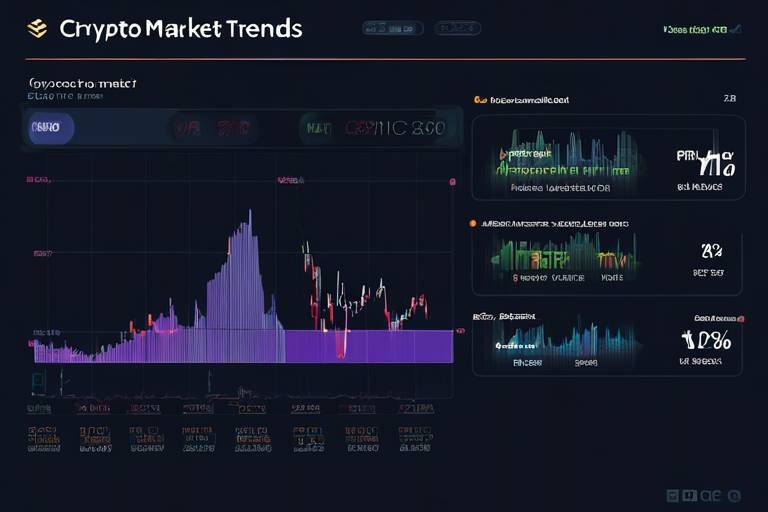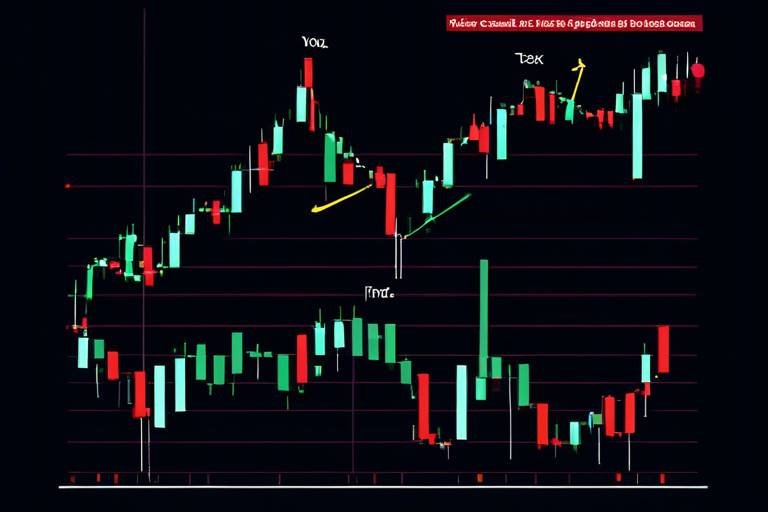Strategies for Trading New and Emerging Cryptocurrencies
In the fast-paced world of cryptocurrency, diving into the realm of new and emerging coins can feel like stepping into a thrilling adventure. The potential for significant gains is enticing, but it also comes with its fair share of risks. So, how do you navigate this volatile landscape? This article explores effective strategies for trading these cryptocurrencies, providing you with insights into market trends, risk management techniques, and the importance of thorough research. By the end, you'll be equipped with the knowledge to make informed decisions and potentially reap the rewards of this exciting market.
Analyzing market trends is crucial for successful cryptocurrency trading. Just like a surfer watches the waves to catch the perfect ride, traders need to observe market signals to seize profitable opportunities. Identifying trends involves looking at price movements, trading volumes, and market sentiment. These elements can provide valuable insights into whether a cryptocurrency is poised for growth or facing a downturn. By leveraging tools such as technical analysis and charting software, you can interpret these signals and make informed trading decisions.
Effective risk management is the backbone of any successful trading strategy. In the unpredictable world of cryptocurrencies, protecting your capital is paramount. One of the simplest yet most effective techniques is to set stop-loss orders. By placing these orders, you can automatically exit a trade if the price falls below a certain level, thereby minimizing potential losses. Additionally, diversifying your investment portfolio is another powerful strategy. Instead of putting all your eggs in one basket, consider spreading your investments across various cryptocurrencies. This approach can help mitigate risks associated with market volatility.
Stop-loss orders can be your safety net in the turbulent waters of cryptocurrency trading. They allow you to define the maximum loss you are willing to tolerate on a trade. For instance, if you buy a cryptocurrency at $100 and set a stop-loss order at $90, your position will automatically close if the price drops to that level, ensuring you don't lose more than $10. However, it’s essential to set these orders thoughtfully. Placing them too close to the current price can result in getting stopped out prematurely, while setting them too far away may expose you to larger losses.
There are different types of stop-loss orders that traders can use, each serving a unique purpose:
- Fixed Stop-Loss: This order is set at a specific price point and remains constant.
- Trailing Stop-Loss: This dynamic order moves with the market price, allowing you to lock in profits while protecting against losses.
Understanding when to use each type can significantly influence your trading outcomes. For example, a trailing stop-loss can be particularly advantageous in a bullish market, as it allows you to capture gains while still having protection in place.
Market conditions are ever-changing, and so should your stop-loss levels. Regularly evaluating your positions and adjusting stop-loss orders can enhance your trading strategies. If a cryptocurrency is experiencing strong upward momentum, consider raising your stop-loss level to secure profits. Conversely, if the market shows signs of weakness, tightening your stop-loss can help protect your capital. This proactive approach can be the difference between a successful trade and a significant loss.
Diversifying your cryptocurrency portfolio is akin to spreading your bets in a casino. By investing in a variety of assets, you can reduce the risk associated with any single investment. When selecting cryptocurrencies for your portfolio, consider factors such as market capitalization, technology, and the team behind the project. A well-rounded portfolio might include a mix of established coins like Bitcoin and Ethereum, alongside promising new entrants. This strategy can help mitigate potential losses during turbulent market conditions.
Research is the cornerstone of successful trading. Before diving into any investment, it's vital to understand the fundamentals of the cryptocurrency in question. This means taking the time to analyze whitepapers, which provide essential insights into a cryptocurrency's purpose, technology, and potential for growth. A well-crafted whitepaper can serve as a roadmap for the project, outlining its goals and how it plans to achieve them.
When analyzing a whitepaper, look for key components such as the problem the cryptocurrency aims to solve, its unique value proposition, and the technology behind it. A clear, concise, and transparent whitepaper can indicate a serious project worth your investment. If a whitepaper is filled with jargon or lacks clarity, it might be a red flag. Remember, a good investment starts with solid research!
Keeping abreast of cryptocurrency news is vital for traders. The crypto market is heavily influenced by external factors, including regulatory changes, technological advancements, and market sentiment. Reliable sources for news include reputable cryptocurrency websites, social media, and forums. By staying informed, you can react swiftly to market developments and adjust your trading strategies accordingly.
- What is the best strategy for trading new cryptocurrencies? A combination of thorough research, understanding market trends, and implementing risk management techniques is essential.
- How can I minimize my losses in cryptocurrency trading? Setting stop-loss orders and diversifying your portfolio are effective ways to minimize potential losses.
- Why is research important in cryptocurrency trading? Research helps you understand the fundamentals of a cryptocurrency, enabling you to make informed investment decisions.

Understanding Market Trends
When stepping into the exhilarating world of cryptocurrency trading, is like having a treasure map. It guides you through the unpredictable landscape, helping you identify where the gold lies and where the pitfalls are. So, how do you become a trend detective in this chaotic market? First, it's essential to grasp the basic principles of market movements.
Market trends can be categorized into three primary types: uptrends, downtrends, and sideways trends. An uptrend is characterized by higher highs and higher lows, indicating a bullish sentiment among traders. Conversely, a downtrend shows lower highs and lower lows, signaling a bearish outlook. Sideways trends indicate market indecision, where prices fluctuate within a narrow range. Recognizing these patterns can significantly impact your trading strategy.
But how do you spot these trends? One effective method is to use technical analysis. By examining price charts and utilizing various indicators, you can gain insights into market momentum. For instance, moving averages smooth out price data to help you identify trends more clearly. The 50-day moving average and the 200-day moving average are particularly popular among traders. When the shorter moving average crosses above the longer one, it often signals a potential uptrend, and vice versa.
Another tool in your arsenal is the Relative Strength Index (RSI), which measures the speed and change of price movements. An RSI above 70 suggests that a cryptocurrency might be overbought, while an RSI below 30 indicates it may be oversold. This information can be crucial for making informed decisions about when to enter or exit trades.
Additionally, keeping an eye on market sentiment can provide valuable context for your trading decisions. Social media platforms, forums, and specialized cryptocurrency news websites are excellent sources for gauging public opinion. You can often detect shifts in sentiment before they manifest in price changes. For example, a sudden surge in positive news about a particular cryptocurrency can lead to an influx of buyers, driving the price up.
However, while market trends can provide guidance, they should not be the sole basis for your trading decisions. Always combine trend analysis with thorough research and risk management strategies. Remember, the crypto market is notoriously volatile, and what goes up can come crashing down just as quickly. So, arm yourself with knowledge, stay alert, and be ready to adapt your strategies as the market evolves.
By mastering the art of understanding market trends, you can position yourself to make more informed trading decisions, ultimately enhancing your chances of success in this fast-paced environment.

Risk Management Techniques
When it comes to trading cryptocurrencies, the thrill of potential profits can often overshadow the inherent risks involved. This is why effective risk management is not just advisable; it's absolutely essential for survival in this volatile market. Imagine you're navigating a stormy sea—without a sturdy ship and a good map, you're bound to capsize. Similarly, having a solid risk management strategy can be your lifeline in the unpredictable world of crypto trading.
One of the most crucial aspects of risk management is setting stop-loss orders. These orders act like safety nets, ensuring that you exit a trade before your losses spiral out of control. Think of them as your personal alarm system; when the market starts moving against you, they trigger an automatic sell-off to limit your losses. But how do you set them effectively? It's not just about picking a random percentage; you need to analyze the asset's volatility and market conditions to determine the best level for your stop-loss.
To set a stop-loss order effectively, consider the following steps:
- Identify Support and Resistance Levels: These are key price points where the asset has historically struggled to move above (resistance) or below (support). Setting your stop-loss just below a support level can provide a buffer against normal market fluctuations.
- Consider Market Volatility: If the market is particularly volatile, you might want to set a wider stop-loss to avoid being stopped out prematurely.
- Use Technical Indicators: Tools like the Average True Range (ATR) can help you gauge how much an asset typically moves, allowing you to set a more informed stop-loss level.
There are different types of stop-loss orders, and understanding them can significantly enhance your trading strategy. Here are the most common types:
| Type | Description | When to Use |
|---|---|---|
| Fixed Stop-Loss | Set at a specific price point. | When you have a clear price target based on technical analysis. |
| Trailing Stop-Loss | Moves with the market price, maintaining a set distance. | When you want to lock in profits while allowing for potential gains. |
As the market evolves, so should your stop-loss levels. Adjusting them based on current market conditions can enhance your trading strategy. For instance, if you're in a profitable trade, you might want to tighten your stop-loss to secure gains. Conversely, if the market shows signs of increased volatility, widening your stop-loss could prevent premature exits. The key is to remain vigilant and ready to adapt your strategy as circumstances change.
Another essential technique in risk management is portfolio diversification. Just like you wouldn't put all your eggs in one basket, investing in a variety of cryptocurrencies can mitigate your risks. By spreading your investments across different assets, you reduce the impact of a single asset's poor performance on your overall portfolio. For example, if one cryptocurrency plummets, others in your portfolio may hold steady or even increase in value, balancing out your losses.
In conclusion, mastering risk management techniques is not just about protecting your capital; it's about empowering yourself to trade with confidence. By setting effective stop-loss orders, understanding their types, adjusting them as needed, and diversifying your portfolio, you can navigate the turbulent waters of cryptocurrency trading with greater ease and security.
Q: What is a stop-loss order?
A: A stop-loss order is a trading tool that automatically sells an asset when it reaches a certain price, helping to limit losses.
Q: How do I determine the right stop-loss level?
A: The right stop-loss level can be determined by analyzing support and resistance levels, market volatility, and using technical indicators.
Q: Why is portfolio diversification important?
A: Diversification helps to spread risk across multiple assets, reducing the impact of any single asset's poor performance on your overall investment.

Setting Stop-Loss Orders
When it comes to trading cryptocurrencies, one of the most effective tools in your arsenal is the stop-loss order. Think of it as your safety net in the unpredictable circus that is the crypto market. A stop-loss order is essentially a pre-set instruction to sell a cryptocurrency when it reaches a certain price. This means that you can limit your potential losses without having to constantly monitor the market. But how do you set these orders effectively? Let's dive into some key strategies.
First off, it's crucial to determine the right price level for your stop-loss. This often depends on your risk tolerance and the volatility of the specific cryptocurrency you're trading. A common approach is to set your stop-loss order at a percentage below the purchase price. For instance, if you buy a coin at $100 and are willing to risk 10%, you would set a stop-loss at $90. This way, if the market takes a turn for the worse, you can exit the trade before incurring substantial losses.
However, merely setting a stop-loss isn't enough. You also need to consider market conditions and adjust your stop-loss levels accordingly. For instance, if the cryptocurrency starts gaining traction and its price rises significantly, you might want to move your stop-loss up to lock in profits. This strategy is often referred to as a "trailing stop." A trailing stop allows you to set a stop-loss that moves with the price, maintaining a certain distance. For example, if your coin rises to $120 and you set a trailing stop at 10%, your stop-loss would automatically adjust to $108.
Another important aspect of setting stop-loss orders is understanding the different types available. Here’s a quick breakdown:
| Type of Stop-Loss Order | Description |
|---|---|
| Fixed Stop-Loss | Set at a specific price point and does not change. |
| Trailing Stop-Loss | Adjusts automatically as the price moves in your favor. |
It's also essential to remember that the market can be unpredictable. Sudden price movements can trigger your stop-loss orders, sometimes at a price that is significantly lower than what you anticipated. This phenomenon is known as "slippage." To mitigate the risk of slippage, consider placing your stop-loss orders at levels that account for market volatility. For instance, if a cryptocurrency is known for its sharp price swings, you might want to set your stop-loss a bit further away from the current price to avoid being kicked out of a trade prematurely.
In conclusion, setting stop-loss orders is a vital part of a robust trading strategy. By carefully selecting your stop-loss levels and understanding the types of orders available, you can protect your investments and navigate the volatile waters of cryptocurrency trading with greater confidence. Remember, trading is not just about making profits; it's equally about managing risks. So, take the time to set those stop-loss orders wisely, and you’ll be well on your way to becoming a more successful trader.
- What is a stop-loss order? A stop-loss order is a pre-set instruction to sell a cryptocurrency when it reaches a specific price to limit potential losses.
- How do I determine the right stop-loss level? The right level often depends on your risk tolerance and market volatility, typically set as a percentage below the purchase price.
- What is a trailing stop-loss? A trailing stop-loss is an order that moves with the price of the asset, allowing you to lock in profits as the price increases.
- Can slippage affect my stop-loss order? Yes, slippage can occur during volatile market conditions, causing your stop-loss to execute at a price different from what you expected.

Types of Stop-Loss Orders
When it comes to protecting your investments in the unpredictable world of cryptocurrencies, understanding the different types of stop-loss orders is essential. Stop-loss orders act as a safety net, allowing you to set predefined exit points for your trades. This way, you can limit your losses without having to monitor the market constantly. Let’s break down the two primary types of stop-loss orders: fixed stop-loss orders and trailing stop-loss orders.
A fixed stop-loss order is straightforward; you set a specific price at which your asset will automatically sell if it drops to that level. For instance, if you purchase a cryptocurrency at $100 and set a fixed stop-loss order at $90, your asset will be sold automatically if the price falls to $90, thus limiting your loss to $10. This type of order is particularly useful for traders who want a clear exit strategy without having to constantly watch the market.
On the other hand, trailing stop-loss orders offer a bit more flexibility. Instead of setting a fixed price, you establish a percentage or dollar amount away from the current market price. As the price of the cryptocurrency rises, the stop-loss order also moves up, thus “trailing” the market price. For example, if you buy a coin at $100 and set a trailing stop-loss of $10, the stop-loss will adjust upwards as the price increases. If the price rises to $120, your stop-loss will move up to $110. However, if the price then falls to $110, your order will trigger and sell your asset, locking in a profit of $10 instead of risking a larger loss.
Both types of stop-loss orders have their advantages and disadvantages. A fixed stop-loss provides clarity and simplicity, making it easier to understand your risk. However, it doesn’t account for market fluctuations that may temporarily dip below your stop-loss level before rebounding. Conversely, a trailing stop-loss can help you capitalize on upward movements, but it may also result in selling too early if the market experiences minor fluctuations. Choosing the right type of stop-loss order depends on your trading style, risk tolerance, and market conditions.
To help visualize these concepts, here’s a simple comparison table:
| Type of Stop-Loss Order | Definition | Best Used When |
|---|---|---|
| Fixed Stop-Loss | Sells an asset at a predetermined price. | When you want a clear exit point without market monitoring. |
| Trailing Stop-Loss | Moves with the market price, allowing for potential gains. | When you want to maximize profits while still protecting against losses. |
In conclusion, understanding the types of stop-loss orders is crucial for any trader looking to navigate the volatile cryptocurrency market effectively. By employing the right stop-loss strategy, you can safeguard your investments and make more informed trading decisions. Remember, the key is to find a balance between risk management and profit potential, tailoring your approach to fit your unique trading style.

Adjusting Stop-Loss Levels
In the fast-paced world of cryptocurrency trading, flexibility is key. Just like a skilled surfer adjusts their stance on the board to ride the waves, traders must adapt their stop-loss levels based on the ever-changing market conditions. So, how do you know when it’s time to make these adjustments? Let’s dive into the factors that can influence your decision.
First and foremost, it’s essential to consider market volatility. Cryptocurrencies can experience sudden price swings, and your initial stop-loss level might not be suitable if the market becomes more turbulent. For instance, if you set a stop-loss at 10% below your entry price, but the market starts fluctuating wildly, you might find yourself exiting a position too early. In such cases, it may be wise to widen your stop-loss to avoid getting stopped out prematurely.
Another factor to consider is the asset's performance. If a cryptocurrency is trending upwards and showing strong momentum, it could be beneficial to adjust your stop-loss to a higher level, locking in profits while still allowing for some breathing room. Think of it like a safety net that catches you without completely halting your potential gains. On the other hand, if the asset is underperforming, tightening your stop-loss could help minimize losses.
Here’s a quick overview of the steps to adjust your stop-loss levels effectively:
- Monitor market conditions regularly to identify shifts in volatility.
- Evaluate the performance of your cryptocurrency and its recent price movements.
- Consider using a trailing stop-loss, which automatically adjusts as the price moves in your favor.
Additionally, it’s crucial to have a clear strategy in place. Are you a short-term trader looking to capitalize on quick gains, or a long-term investor holding for future potential? Your trading style will influence how you adjust your stop-loss levels. Short-term traders might prefer tighter stop-losses to protect against quick market reversals, while long-term investors may opt for wider stops to ride out the volatility.
Lastly, always remember that adjusting stop-loss levels isn’t a one-size-fits-all approach. Each trader's risk tolerance and strategy will vary. It’s essential to regularly review your positions and be willing to adapt your stop-loss levels as needed. By doing so, you can navigate the unpredictable waters of cryptocurrency trading with confidence and poise.
Q: What is a stop-loss order?
A stop-loss order is an instruction to sell an asset when it reaches a certain price, helping to limit potential losses.
Q: How often should I adjust my stop-loss levels?
It depends on market conditions and your trading strategy. Regularly monitor your positions and adjust as necessary.
Q: Can I use trailing stop-loss orders?
Yes! Trailing stop-loss orders automatically adjust as the price moves in your favor, providing a dynamic way to protect profits.

Portfolio Diversification
When it comes to trading new and emerging cryptocurrencies, is not just a buzzword—it's a fundamental principle that can significantly mitigate risks. Think of your investment portfolio as a garden. If you only plant one type of flower, a single pest or disease can wipe out your entire garden. However, if you mix various plants, some may thrive even if others struggle. In the same way, diversifying your crypto investments can protect you from the volatility that often plagues the cryptocurrency market.
To effectively diversify your portfolio, it’s essential to consider a variety of factors. First, you want to include different types of cryptocurrencies. This could mean investing in established coins like Bitcoin and Ethereum, while also exploring newer tokens that show potential for growth. Each cryptocurrency operates under different market dynamics, which can help balance your overall risk. For instance, while Bitcoin may be more stable, altcoins can offer higher potential returns—albeit with increased risk.
Moreover, it’s crucial to pay attention to the underlying technology and use cases of the cryptocurrencies you choose to invest in. Here are some categories you might consider:
- Payment Tokens: Cryptocurrencies designed for transactions.
- Utility Tokens: Tokens that provide access to a product or service.
- Stablecoins: Cryptocurrencies pegged to a stable asset, like the US dollar.
- DeFi Tokens: Tokens associated with decentralized finance applications.
By mixing these categories, you can create a more balanced portfolio that can weather market fluctuations. Additionally, it’s wise to consider geographic diversification. Just as you wouldn’t want to invest all your money in one local business, investing in cryptocurrencies from different regions can spread your risk further. For example, you might look at projects emerging from North America, Europe, and Asia, each with unique regulatory environments and market opportunities.
Another key aspect of portfolio diversification is regularly rebalancing your investments. The cryptocurrency market is known for its rapid changes, and what seemed like a sound investment yesterday might not hold the same value tomorrow. By periodically reviewing your portfolio and adjusting your holdings based on performance and market trends, you can ensure that you’re not overly exposed to any single asset.
In conclusion, effective portfolio diversification requires a blend of different cryptocurrencies, an understanding of their use cases, and a proactive approach to managing your investments. Just like a well-tended garden, a diversified portfolio can flourish even in the face of market challenges. Remember, the goal is not to eliminate risk entirely but to manage it wisely, allowing you to navigate the exciting yet unpredictable world of cryptocurrency trading.
1. Why is portfolio diversification important in cryptocurrency trading?
Diversification helps mitigate risks by spreading investments across various assets. This way, if one asset performs poorly, others may perform well, balancing out potential losses.
2. How many different cryptocurrencies should I include in my portfolio?
There's no one-size-fits-all answer, but a good rule of thumb is to have at least 5-10 different cryptocurrencies across various categories to achieve meaningful diversification.
3. Should I diversify geographically as well?
Absolutely! Investing in cryptocurrencies from different regions can provide additional protection against localized market downturns or regulatory changes.
4. How often should I rebalance my portfolio?
It's advisable to review your portfolio at least quarterly, but you may want to do so more frequently in the highly volatile cryptocurrency market.

Conducting Thorough Research
When it comes to trading new and emerging cryptocurrencies, is not just a suggestion; it's a necessity. Think of it as your compass in a vast ocean of digital currencies. Without it, you might find yourself lost, navigating through the unpredictable waves of the crypto market. So, how do you ensure that your research is both comprehensive and effective? Let’s dive into the essential components that make up a robust research strategy.
First and foremost, understanding the fundamentals of a cryptocurrency is crucial. This means digging into its whitepaper, which serves as the project's blueprint. A well-crafted whitepaper will outline the cryptocurrency's purpose, the technology behind it, and the problems it aims to solve. For instance, if a cryptocurrency claims to enhance transaction speeds, does its whitepaper provide a clear explanation of how it achieves this? When analyzing a whitepaper, consider the following key elements:
- Problem Statement: What issue does the cryptocurrency address?
- Technology: What technology underpins the project, and is it innovative?
- Team: Who are the developers behind the project? Do they have a credible background?
- Roadmap: What are the future plans for the cryptocurrency?
Once you've scrutinized the whitepaper, the next step is to stay updated with the latest news in the cryptocurrency space. The market is incredibly dynamic, and new developments can significantly impact the value of your investments. Reliable sources of information include reputable cryptocurrency news websites, forums, and social media platforms. Following industry leaders and influencers on platforms like Twitter and LinkedIn can also provide valuable insights. Remember, knowledge is power, especially in a market where rumors can lead to drastic price swings.
Additionally, monitoring social sentiment can offer clues about market trends. Tools like Google Trends or social media analytics platforms can help you gauge public interest in a particular cryptocurrency. If you notice an uptick in discussions or searches, it could indicate a growing interest that might lead to price increases. However, be cautious; just because something is trending doesn't mean it's a good investment. Always cross-reference your findings with other research.
Moreover, consider joining cryptocurrency communities and forums. Engaging with other traders and enthusiasts can provide you with different perspectives and insights that you might not have considered. Platforms like Reddit and Discord have vibrant communities where members discuss their experiences, share tips, and analyze market trends. Just remember to approach these discussions with a critical eye; not all advice is sound.
In summary, conducting thorough research is your best defense against the inherent risks of trading new and emerging cryptocurrencies. By analyzing whitepapers, staying informed on news, monitoring social sentiment, and engaging with the community, you can make more informed trading decisions. This proactive approach will not only enhance your understanding of the market but also increase your chances of success in the ever-evolving crypto landscape.
Q: Why is researching new cryptocurrencies important?
A: Researching new cryptocurrencies is crucial because it helps you understand the project's fundamentals, potential risks, and growth opportunities, allowing for informed investment decisions.
Q: What should I look for in a cryptocurrency whitepaper?
A: Key elements to look for include the problem statement, technology used, the team's background, and the project's roadmap.
Q: How can I stay updated with cryptocurrency news?
A: You can stay updated by following reputable news websites, social media platforms, and industry leaders. Joining cryptocurrency communities can also provide valuable insights.
Q: Is social sentiment analysis helpful in cryptocurrency trading?
A: Yes, monitoring social sentiment can help you gauge public interest and potential market movements, but always validate findings with thorough research.

Analyzing Whitepapers
When it comes to trading new and emerging cryptocurrencies, is like peeking behind the curtain of a magic show. It's where the real magic happens, revealing the intentions and mechanics of a cryptocurrency project. A whitepaper is essentially a detailed document that outlines the project's goals, technology, and roadmap. Think of it as the blueprint for a house; without it, you might end up with a structure that's not only unstable but also misaligned with your vision.
To effectively analyze a whitepaper, you need to focus on several key components:
- Project Overview: This section provides insights into the problem the cryptocurrency aims to solve. Is it addressing a significant issue in the market, or is it just another coin in a sea of tokens?
- Technology: Look for details on the underlying technology. Is the project utilizing blockchain in a novel way? Are there unique features that set it apart from competitors?
- Tokenomics: Understanding the distribution and utility of the token is crucial. How many tokens are in circulation? What incentives are there for holding the token versus selling it?
- Roadmap: A clear and realistic roadmap indicates a well-thought-out plan for development. Are the milestones achievable, and do they align with the current market trends?
As you dive into the whitepaper, don't just skim through the text. Take your time to absorb the information. Look for red flags such as vague language, lack of technical details, or unrealistic promises. If a project claims to "revolutionize" the industry without providing substantial evidence, it's a signal to proceed with caution.
Another important aspect is to check the team behind the project. A strong team with a proven track record can often be a good indicator of the project's potential success. Look for their backgrounds, previous projects, and involvement in the cryptocurrency community. If the team is anonymous or lacks relevant experience, it might be worth reconsidering your investment.
In summary, analyzing whitepapers is not just a formality; it’s a critical step in your trading strategy. By understanding the project's fundamentals, you can make more informed decisions and potentially avoid costly mistakes. So, the next time you come across a shiny new cryptocurrency, take a moment to peel back the layers and see what lies beneath. It could save you from investing in a mirage.
Q: What should I look for in a cryptocurrency whitepaper?
A: Focus on the project overview, technology, tokenomics, and roadmap. Ensure that the information is clear, detailed, and realistic.
Q: How important is the team behind a cryptocurrency?
A: Extremely important! A strong, experienced team can significantly impact a project's success. Research their backgrounds and previous projects.
Q: Can I rely solely on whitepapers for investment decisions?
A: While whitepapers are crucial, they should be part of a broader research strategy that includes market trends, community sentiment, and news updates.

Staying Updated with News
In the fast-paced world of cryptocurrency, staying updated with the latest news is not just a good practice; it's a necessity! Imagine trying to navigate through a stormy sea without a compass—this is what trading cryptocurrencies can feel like without proper information. The market is constantly evolving, and new developments can have a significant impact on prices. Therefore, it’s essential for traders to keep their fingers on the pulse of the market.
One of the best ways to stay informed is by following reliable news sources. Websites like CoinDesk, CoinTelegraph, and CryptoSlate provide timely updates and in-depth analyses of market trends. Additionally, social media platforms, particularly Twitter and Reddit, can be goldmines for real-time news and community insights. Just remember, while social media can be informative, it can also spread misinformation, so always double-check facts before making any trading decisions.
Moreover, subscribing to newsletters from trusted crypto analysts can provide you with curated content directly to your inbox. Many analysts share valuable insights and predictions that can help you make informed decisions. You might also consider joining forums or groups where traders discuss recent events and share their perspectives. Engaging in discussions can enhance your understanding and provide different viewpoints on market movements.
To make it easier for you, here’s a quick overview of some effective methods for staying updated:
- Follow Reliable News Websites: These should be your go-to sources for accurate information.
- Engage with Social Media: Platforms like Twitter and Reddit can provide real-time updates and community insights.
- Subscribe to Newsletters: Get curated content from trusted analysts directly to your inbox.
- Join Crypto Forums: Engage in discussions to gain different perspectives on market movements.
In addition to these methods, consider setting up Google Alerts for specific cryptocurrencies or market terms. This way, you can receive notifications whenever there’s news related to your interests. This proactive approach ensures you’re never out of the loop and can react quickly to any changes.
Lastly, remember that while it’s important to stay informed, it's equally crucial to filter out noise. The cryptocurrency market can be influenced by hype and speculation, so always approach news with a critical mind. By focusing on well-researched information and maintaining a balanced perspective, you can navigate the volatile waters of cryptocurrency trading with greater confidence.
Q: How often should I check cryptocurrency news?
A: It’s advisable to check news regularly, at least once a day, to stay updated on significant developments that could affect the market.
Q: Are there any specific news sources you recommend?
A: Yes! Some reliable sources include CoinDesk, CoinTelegraph, and CryptoSlate for timely updates and analyses.
Q: Can social media be trusted for cryptocurrency news?
A: While social media can provide real-time updates, it’s essential to verify information from credible sources to avoid misinformation.
Q: What are Google Alerts, and how can they help?
A: Google Alerts are notifications that you can set up to receive updates on specific topics, ensuring you stay informed about the latest news related to your interests.
Frequently Asked Questions
- What are the key strategies for trading new cryptocurrencies?
When trading new cryptocurrencies, it's essential to focus on understanding market trends, managing risks effectively, and conducting thorough research. By analyzing price movements and market signals, you can make informed decisions. Additionally, implementing risk management techniques like stop-loss orders and diversifying your portfolio can help protect your investments.
- How can I identify market trends in cryptocurrency trading?
Identifying market trends involves analyzing historical price data and recognizing patterns. Tools like charts and technical indicators can assist in spotting upward or downward trends. Moreover, staying updated with market news and social media discussions can provide valuable insights into current sentiments and potential movements.
- What is a stop-loss order, and how does it work?
A stop-loss order is a trading tool designed to limit potential losses by automatically selling a cryptocurrency when it reaches a specific price point. This helps you exit a trade before losses escalate. There are various types of stop-loss orders, including fixed and trailing, each serving different strategic purposes in your trading plan.
- What are the different types of stop-loss orders?
There are two primary types of stop-loss orders: fixed and trailing. A fixed stop-loss order remains at a set price, while a trailing stop-loss adjusts as the market price moves in your favor. Understanding when to use each type can significantly enhance your risk management strategy.
- Why is portfolio diversification important in cryptocurrency trading?
Diversifying your cryptocurrency portfolio helps spread risk across various assets, reducing the impact of a poor-performing investment. By investing in different cryptocurrencies, you can mitigate potential losses and increase your chances of capitalizing on market opportunities.
- How do I analyze a cryptocurrency's whitepaper?
Analyzing a whitepaper involves examining its content for clarity, purpose, and technological innovation. Look for details on the project's goals, the problem it aims to solve, the team behind it, and its roadmap. A well-structured whitepaper often indicates a promising investment opportunity.
- What are reliable sources for staying updated on cryptocurrency news?
To stay informed about cryptocurrency developments, consider following reputable news websites, financial platforms, and social media channels. Some popular sources include CoinDesk, CoinTelegraph, and Reddit communities focused on cryptocurrency discussions. Regularly checking these sources can help you make timely trading decisions.



















